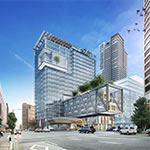The opportunity for an architect to design nearly an entire downtown city block is rare, but then again, so are projects with the ambitions of Vancouver’s Telus Garden. Bound on its four sides by Georgia, Robson, Seymour, and Richards streets, Telus Garden consists of one million square feet of new real estate: half a million square feet of intended LEED Platinum office space and more than 400 LEED Gold residential units.
Various elements make it clear that Telus Garden, developed by Westbank to be the Vancouver headquarters of Canadian telecommunications company Telus, is breaking new ground for the city: 10,000 square feet of green roofs, two roof forests, a future geothermal heat plant, and extensive and intelligent reuse of waste energy—not to mention the local art and media walls intended for public broadcasts of symphonies and other cultural events. The city block’s worth of pedestrian laneways, or people-friendly alleys, will include a lantern-lit walkway at night within the interior of the development, pushing urban planning in Vancouver toward walkability.
Local firm Henriquez Partners Architects designed the project and collaborated with Integral Group, which has offices in the United States and London, to design its innovative energy systems with a goal of ensuring that Telus Garden will include Vancouver’s first LEED Platinum tower. (Integral is also responsible for certification.)

A major feature of Telus Garden is the steel canopy ribbed with glulam beams that spans an entire city block and shelters the pedestrian walkway.

A custom Fazioli piano, designed by Henriquez Partners Architects principal Gregory Henriquez, will enliven the lobby.
DETAILS
Location Vancouver, British Columbia
Program 44-story residential tower, 22-story office tower
Size 1 million ft2
Completion 2015 (expected)
Certification LEED Platinum (office, expected) LEED Gold (residential, expected)
Cost $750 million
Architect Henriquez Partners Architects
Developer Westbank
ME Engineer / Sustainability Integral Group
Construction Manager ICON Pacific
Client TELUS
Sean Pander, the director of sustainability at the City of Vancouver, says energy benchmarking for existing buildings is a critical part of reducing greenhouse gas emissions. Goran Ostojic, the managing principal for Integral’s Vancouver office, agrees and says North America is five to ten years behind Europe in tying economic incentives to energy performance. “This is a $750 million building. There should be tax breaks if it succeeds in its energy reduction and LEED Platinum performance,” Ostojic says. “Some portion of tax should be correlated to performance.”
Ostojic relates it to owning a car. “If you buy a car, in order to maintain the warranty, every three months you have to change the oil and do a variety of things,” he says. “Yet we still have this sense in the operations of a building [that if] no one is complaining, I’m happy. But if you build a Ferrari, you want it to run as a Ferrari.”
And Telus Garden is a Ferrari. From its district waste-to-energy system (80 percent of the primary heating and cooling is from the data center), to the exposed slab ceiling with radiant heating and cooling and displacement ventilation, the project is unlike any Vancouver has ever seen. The triple-glazed windows and the interior and exterior shading help counter the adverse effects—increased energy use and carbon intensity—of floor-to-ceiling glass (which is actually illegal in many European countries).
“We started to find wonderful synergies [in] looking at things differently,” says Peter Wood, the director of architecture at Henriquez Partners Architects. “For instance, we needed to harvest a certain quantity of rainwater, and we were coming up short. We only had so much roof area that could collect water, but then we realized that the PV array itself could collect … rain. All the water that falls on the PVs is collected in a gutter and channeled to a cistern in the basement for greywater and irrigation.”
The design team also made a concerted effort to ensure that the buildings, which currently constitute the largest construction project in Vancouver, is visibly and obviously sustainable. “We wanted it to be different than other office buildings,” Wood says, “and to have those differences be recognizable as sustainable strategies by the public—the building itself becoming the message of the corporation’s commitment to a better work environment and a better world.”
—
 MORE ON VANCOUVER
MORE ON VANCOUVER
“I’m proud to live in a highly walkable and bikeable city. That’s a product of sustained effort by Vancouver’s people, planners, and politicians over many years.”
– Morgan McDonald, Director of Operations, Ledcor Renew
 “We have abstracted ourselves from the physical world, and we need to get that connection back.”
“We have abstracted ourselves from the physical world, and we need to get that connection back.”
– Teresa Coady, COO, Kasian

